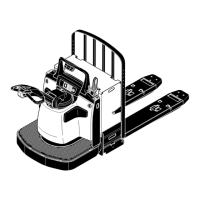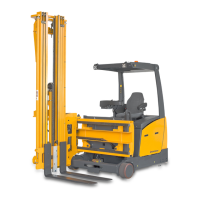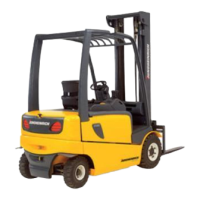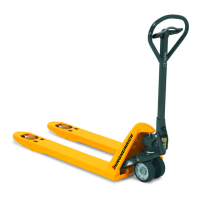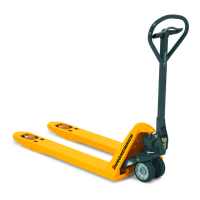03.11 EN
52
4.3 Lifting, transporting and depositing loads
WARNING!
Unsecured and incorrectly positioned loads can cause accidents
Before lifting a load unit the driver must make sure that it has been correctly palletised
and does not exceed the truck’s capacity.
XInstruct other people to move out of the hazardous area of the truck. Stop working
with the truck if people do not leave the hazardous area.
XOnly carry loads that have been correctly secured and positioned. Use suitable
precautions to prevent parts of the load from tipping or falling down.
XDamaged loads must not be transported.
XNever exceed the maximum loads specified in the capacity chart.
XNever stand underneath a raised load handler.
XDo not stand on the load handler.
XDo not lift other people on the load handler.
XInsert the forks as far as possible underneath the load.
NOTE
With the two-stage Duplex mast (ZZ) the short, centre-mounted free lift cylinder
initially lifts the load carriage (free lift) without changing the overall height of the truck.
NOTE
Adapt a slower speed when stacking and retrieving.
4.3.1 Lifting load units
Requirements
– Load unit correctly palletised.
– Load unit weight matches the truck's
capacity.
– Forks evenly loaded for heavy loads.
Procedure
• Drive the truck carefully up to the pallet.
• Slowly insert the forks into the pallet until the
fork shank touches the pallet.
Z The load unit must not extend by more than
50 mm beyond the fork tips.
• Press the “Lift” button (49) button until you reach the desired lift height.
The load unit is raised.
Z The lift/lower speed can be infinitely controlled through the movement of the button.
Short stroke = slow lift / lower
49
48
03.11 EN
52
4.3 Lifting, transporting and depositing loads
WARNING!
Unsecured and incorrectly positioned loads can cause accidents
Before lifting a load unit the driver must make sure that it has been correctly palletised
and does not exceed the truck’s capacity.
XInstruct other people to move out of the hazardous area of the truck. Stop working
with the truck if people do not leave the hazardous area.
XOnly carry loads that have been correctly secured and positioned. Use suitable
precautions to prevent parts of the load from tipping or falling down.
XDamaged loads must not be transported.
XNever exceed the maximum loads specified in the capacity chart.
XNever stand underneath a raised load handler.
XDo not stand on the load handler.
XDo not lift other people on the load handler.
XInsert the forks as far as possible underneath the load.
NOTE
With the two-stage Duplex mast (ZZ) the short, centre-mounted free lift cylinder
initially lifts the load carriage (free lift) without changing the overall height of the truck.
NOTE
Adapt a slower speed when stacking and retrieving.
4.3.1 Lifting load units
Requirements
– Load unit correctly palletised.
– Load unit weight matches the truck's
capacity.
– Forks evenly loaded for heavy loads.
Procedure
• Drive the truck carefully up to the pallet.
• Slowly insert the forks into the pallet until the
fork shank touches the pallet.
Z The load unit must not extend by more than
50 mm beyond the fork tips.
• Press the “Lift” button (49) button until you reach the desired lift height.
The load unit is raised.
Z The lift/lower speed can be infinitely controlled through the movement of the button.
Short stroke = slow lift / lower
49
48
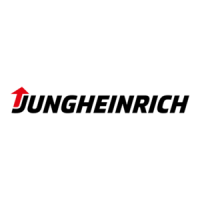
